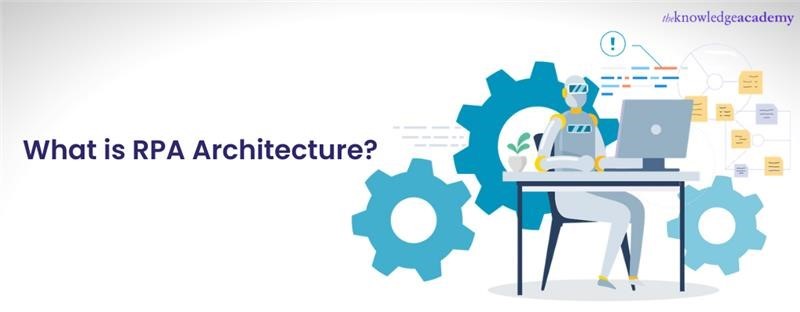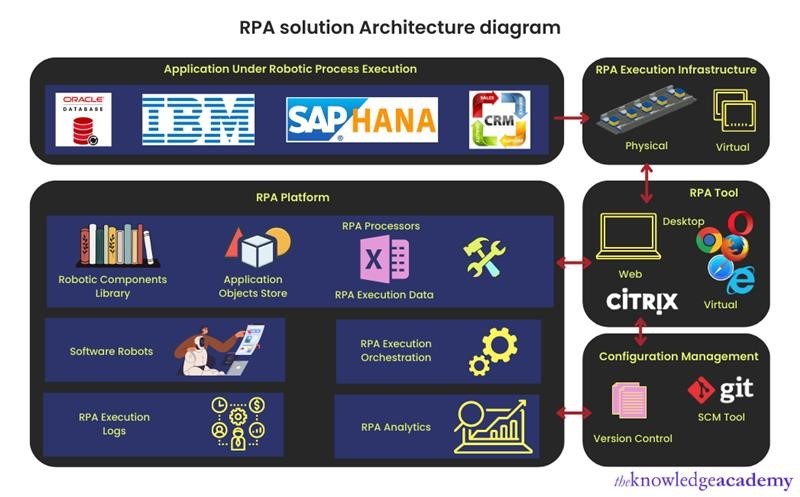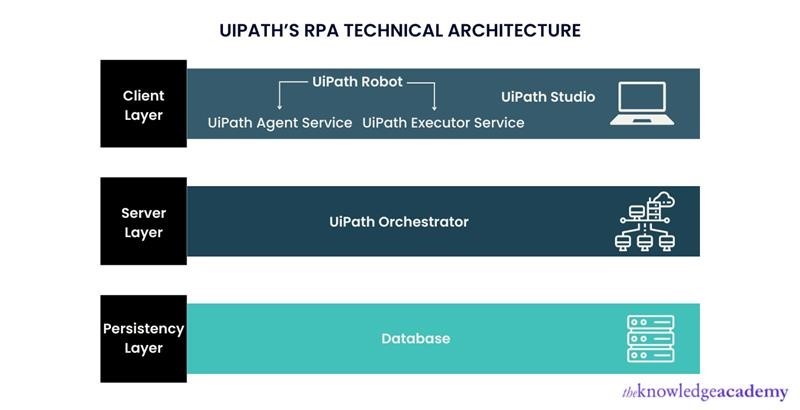We may not have the course you’re looking for. If you enquire or give us a call on 01344203999 and speak to our training experts, we may still be able to help with your training requirements.
Training Outcomes Within Your Budget!
We ensure quality, budget-alignment, and timely delivery by our expert instructors.

RPA allows enterprises to progress in overall productivity, thanks to the efficiency and resilience of machines, which humans are incapable of. Robotic Process Automation, or RPA, allows robots and software to replicate and perform menial human tasks more efficiently. The framework and components of such automation are referred to as RPA Architecture.
RPA allows organisations to automate their work, reducing overall productivity inconsistency and making it extremely popular globally. According to Statista, the RPA market is expected to grow to 10.8 billion GBP by 2030. Such technology will make you curious about its working and components, which is what we will do in this blog. This blog will help you learn what is Robotic Process Automation (RPA) Architecture and the architectural design of how RPA works.
Table of Contents
1) An Overview of RPA Architecture
a) Utility
b) Integration
c) Security
d) Integrity
e) Layout
f) Deployment
2) What are the components of RPA Architecture?
3) Tools in Architecture of RPA
4) Conclusion
An Overview of RPA Architecture
RPA lets enterprises have fully automated functioning with close to zero instances of human errors. RPA includes robots or mechanical tools that interact with software and perform tasks that earlier required manual intervention. These tasks are possible within RPA's Architecture due to the presence of multiple components, where each component is an essential part of the RPA mechanics.
Generally, these tasks are performed via a User Interface (UI). However, without UI, robots can utilise web services to exchange information with different components. These components of RPA and their working with each other are referred to as RPA's Architecture. Some such components might include the software, the robots, the execution logs, and the analytics performed to determine the work of the RPA.
Before we go on to the workings of such components, let's understand the necessary factors that play a crucial role in implementing such features.
Utility
Utility significantly affects an RPA's scalability, adoption rate and deployment efficiency. A high utility component is easy to configure and administer, which brings ease of understanding for others. This makes utility an essential aspect of automation, vital to RPA creation.
Integration
RPA is not limited to just performing menial tasks. Its most significant advantage is its ability to connect with other tools, creating an effective chain of command. This ability of an RPA to integrate with other machines and tools allows it to make a smoother workflow.
Security
RPA must be secure as it contains precious business data while in use. An RPA component needs to be considered carefully based on the type of data it may use. Different automation toolkits come with varying security features; you need to choose which one is right for your business.
Integrity
The integrity of automation refers to its ability to handle unforeseen circumstances. This becomes defining factor in the successful implementation of any intelligence-based tool. It may include taking an alternative approach to a problem or informing experts through a distress call.
In ideal circumstances, automation can take care of the problem by itself. If the automation cannot deal with the error, it should be able to inform the proper authority who might have a solution. The lack of such error-handling capabilities makes automation inconsistent with its productivity and vulnerable to external factors.
Layout
A good RPA tool comes with inbuilt options to configure its general layout. This configuration mechanism allows a user to customise the said tool in accordance with their need. Performing such changes in the layout is necessary to buff up an RPA’s internal capabilities.
Deployment
Deployment is the final and vital part of RPA implementation. The initial deployment phase includes providing updated robotic scripts and variable creation based on the environment and the need for RPA.
The deployment process depends considerably on support from RPA vendors. No RPA tool is initially perfect; their implementation varies based on the enterprise. An enterprise can be famous or a new competitor in the field. This means the growth of the business and its automation depends a lot on the support which facilitates the necessary changes based on the working environment of RPA.

What are the components of RPA Architecture?

It's a standard thought that architecture consists of multiple elements, and RPA is no different. It consists of other factors which affect the working and results of automation rather than a singular entity. RPA Architecture is divided into many layers, each representing a level of complexity in which functions are performed here.
Some of such layers are the process, sub-process, and object layers, consisting of different entities. Lastly, these components refer to every small aspect that comes together to form the architecture successfully. Let's take some time to understand the working and importance of components of Architecture in RPA.
Robotic Process Application
Simple data processing applications like Enterprise Resource Planning (ERP), System Application & Products (SAP) and Mainframes are laced with repetitive tasks. These tasks are perfect for Robotic Automation, making such apps an initial component of RPA’s Architecture.
Tools
Tools are another vital component of the RPA. Tools serve various functions in an architecture, such as automating different application environments. They also include software robot development, allowing them to process files in video formats and enhance them further.
Tools allow you to create reusable components with versatile applications. The RPA tools will enable UI creation for storing objects and depositories for locating.
Platform
Platforms like the cloud allow you to store software robots and other resources by creating a depository. These resources, such as robots, can be divided based on classifications. The platform allows you to monitor, schedule, and distribute the software robot execution. The RPA platform will also enable you to perform analytics using collective information on all executions and assets.
Infrastructure
RPA's infrastructure generally consists of virtual or physical machines. These platforms are controlled with usage patterns, allowing an increase and decrease in the number of devices running in parallel. This requires no human interaction, allowing you to leave it unattended.
Configuration
Configuration Management allows for proper mitigation of different layers present within the RPA's architecture. This also will enable RPA to perform the boring, redundant data-heavy tasks successfully but also constantly update underlying applications of RPA. This further proves that RPA isn't a singular entity but a chain of components. Finding the right combination of features allows you to build a perfect model for your business.
Wish to get a head start in RPA solutions? Our course in OpenSpan RPA Training is here for you!
Tools in Architecture of RPA
RPA tools allow handling exceptions, writing and reading from various data sources and building reusable components. These tools enable automation creation across different platforms such as Citrix, Web and Desktop. UiPath is one such popular RPA tool. Let's look at UiPath and its architecture.
UiPath
UiPath is a popular RPA tool with drag and drop interface. This allows for ease of usage as well as an efficient workflow. UiPath has three core components that define its working traits and functionality; let's understand them.
1) UiPath Studio: The studio allows you to create the workflow for automation in a visual designer interface. It contains features like Graphic User Interface (GUI) dashboard, debugging and error handling and Optical Character Recognition (OCR). UiPath studio allows three complexity levels for project creation. The three complexity levels are Sequence level complexity, Flowchart level complexity and State Machine level complexity
2) UiPath Robot: UiPath allows you to create and run multiple robots simultaneously. These robots allow for the execution of automation workflow. As these robots are necessary for automation, they must be running to execute any tasks. UiPath robot is further divided into two components as follows.
a) Agent Service: This service can change settings, changing working status from stop to start or vice versa. It is also used to display the jobs available in the system tray.
b) Executor Service: Executor Service in UiPath runs jobs given under windows session.
3) UiPath Orchestrator: As its name suggests, Orchestrator is a component in UiPath RPA which allows you to Orchestrate robots. The general workflow for Orchestrator is creating a robot for task execution and creating a project. Once the project is published, it can be utilised by the robot as a process in a specific environment, thus creating a job.

UiPath RPA Architecture
The Architecture of UiPath consists of three layers, each consisting of certain components. This division exists based on how a component operates and its degree of impact. Let's look at the layers and their respective function within the Architecture of UiPath.
1) Client layer: This layer includes the UiPath Robots and UiPath Studio. This layer deals monthly with automation and their workflows.
2) Server layer: This layer includes the Orchestrator server. The orchestrator and server layer is responsible for monitoring, configuring, logging and managing queues.
3) Persistency layer: Lastly, the Persistency layer contains a database that takes a recording of all information on robots and their execution queues and their items.
Wish to design your own RPA? Our Microsoft Power Automate RPA Developer PL500 course if for you!
Conclusion
RPA allows you to remove any possibility of human errors from your business practices and brings mechanical consistency to an enterprise. RPA is not limited by the factors that affect humans, such as sickness, boredom and lack of consistency. To implement such a system successfully, it’s vital to understand the components of RPA and its architecture. Hopefully, this blog helped you understand RPA and establish the best RPA Architecture according to your need.
Interested in UiPath? Try our course in Robotic Process Automation Using UiPath today!
Frequently Asked Questions
Upcoming Business Analysis Resources Batches & Dates
Date
 Robotic Process Automation using UiPath
Robotic Process Automation using UiPath
Thu 12th Sep 2024
Thu 7th Nov 2024
Thu 12th Dec 2024







 Top Rated Course
Top Rated Course


 If you wish to make any changes to your course, please
If you wish to make any changes to your course, please


